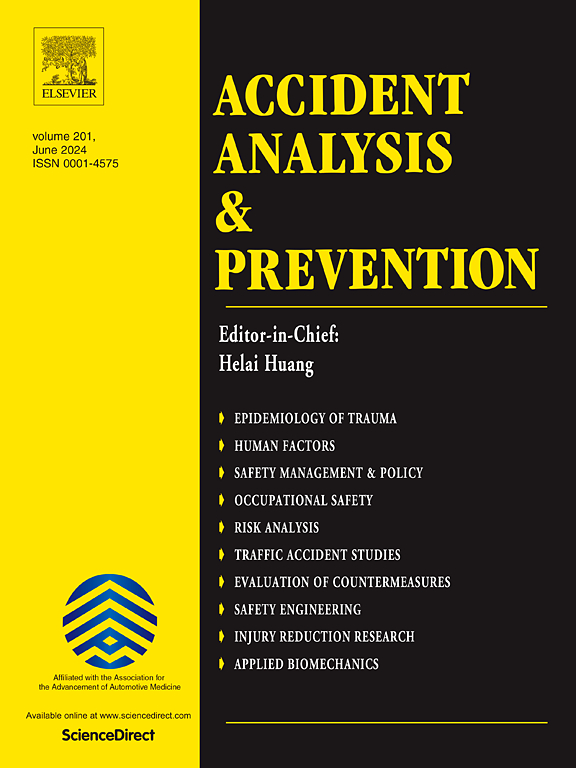基于交通冲突分析的交叉口微观热点识别
IF 6.2
1区 工程技术
Q1 ERGONOMICS
引用次数: 0
摘要
识别交通碰撞热点的传统方法主要集中在确定道路网络中的危险十字路口,忽略了十字路口内碰撞风险的变化。微观层面的崩溃热点分析通过精确识别特定的高风险区域来解决这个问题。本研究旨在利用无人机视频衍生的交通冲突度量来识别三个信号交叉口的微观热点。该算法基于不同的车辆尺寸和冲突角度来计算冲突。本研究中的交通冲突度量包括:碰撞时间(time-to-collision, TTC),即匀速条件下发生潜在碰撞的时间;修正碰撞时间(MTTC),它通过假设恒定加速度来检测冲突;和后侵占时间(PET),两辆车通过同一点的时间间隔。为了在每个路口选择最合适的冲突措施并确定最佳阈值,我们使用广义线性建模(GLM)建立了碰撞频率模型。这些选择的冲突度量和阈值随后用于通过核密度检测微观级热点区域。结果表明,TTC和PET与微观层面的碰撞频率密切相关,并随碰撞角度和交叉口位置的不同而呈现出不同的模式。具体而言,基于ttc的冲突与发生在停车线前的追尾事故高度相关,而基于pet的冲突与发生在十字路口内的事故密切相关,特别是与左转运动密切相关。本研究通过识别微观层面热点的交通冲突措施,并提供详细的安全干预措施,为交叉口安全做出贡献。这些干预措施包括加强路面标记、调整停车线位置、延长左转停车位或分隔自行车道,这些措施都是基于研究中观察到的特定冲突模式。本文章由计算机程序翻译,如有差异,请以英文原文为准。
Micro-level hotspot identification at intersections using traffic conflict analysis
Traditional approaches to identifying traffic crash hotspots have mainly focused on determining dangerous intersections within road networks, overlooking variations in crash risk within intersections. The micro-level crash hotspot analysis addresses this issue by identifying specific high-risk areas with precision. This study aims to identify micro-level hotspots within three signalized intersections using traffic conflict measures derived from drone video. An algorithm calculates conflicts based on various vehicle sizes and conflict angles. The traffic conflict measures in this study include time-to-collision (TTC), the time to a potential collision assuming constant speed; modified time-to-collision (MTTC), which detects conflicts by assuming constant acceleration; and post-encroachment time (PET), the time gap between two vehicles passing the same point. To select the most appropriate conflict measures and determine optimal thresholds at each intersection, we develop crash frequency models using generalized linear modeling (GLM). These selected conflict measures and thresholds are subsequently used to detect micro-level hotspot sections through kernel density. The results demonstrate that the TTC and PET are strongly related to micro-level crash frequencies, with different patterns emerging depending on crash angle and intersection location. Specifically, TTC-based conflicts are highly correlated with rear-end crashes occurring before the stop line, while PET-based conflicts are closely associated with crashes within the intersection, particularly with left-turning movements. This study contributes to intersection safety by identifying traffic conflict measures for micro-level hotspots and offering detailed safety interventions. These interventions include pavement marking enhancements, stop-line location adjustment, extended left-turn bays, or separated bike lanes, which are based on the specific conflict patterns observed in the study.
求助全文
通过发布文献求助,成功后即可免费获取论文全文。
去求助
来源期刊

Accident; analysis and prevention
Multiple-
CiteScore
11.90
自引率
16.90%
发文量
264
审稿时长
48 days
期刊介绍:
Accident Analysis & Prevention provides wide coverage of the general areas relating to accidental injury and damage, including the pre-injury and immediate post-injury phases. Published papers deal with medical, legal, economic, educational, behavioral, theoretical or empirical aspects of transportation accidents, as well as with accidents at other sites. Selected topics within the scope of the Journal may include: studies of human, environmental and vehicular factors influencing the occurrence, type and severity of accidents and injury; the design, implementation and evaluation of countermeasures; biomechanics of impact and human tolerance limits to injury; modelling and statistical analysis of accident data; policy, planning and decision-making in safety.
 求助内容:
求助内容: 应助结果提醒方式:
应助结果提醒方式:


